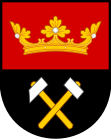Královské Poříčí
| Královské Poříčí | ||||
|---|---|---|---|---|
|
||||
| Basic data | ||||
| State : |
|
|||
| Region : | Karlovarský kraj | |||
| District : | Sokolov | |||
| Area : | 1219.7729 ha | |||
| Geographic location : | 50 ° 12 ' N , 12 ° 41' E | |||
| Height: | 396 m nm | |||
| Residents : | 785 (Jan. 1, 2019) | |||
| Postal code : | 357 41 | |||
| License plate : | K | |||
| traffic | ||||
| Street: | Sokolov - Nové Sedlo | |||
| Railway connection: | Chomutov – Cheb | |||
| Next international airport : | Karlovy Vary Airport | |||
| structure | ||||
| Status: | local community | |||
| Districts: | 2 | |||
| administration | ||||
| Mayor : | Michal Skýba (as of 2018) | |||
| Address: | Lázeňská 159 357 41 Královské Poříčí |
|||
| Municipality number: | 560464 | |||
| Website : | www.kralovske-porici.cz | |||
| Location of Královské Poříčí in the Sokolov district | ||||

|
||||
Královské Poříčí (German Königswerth ) is a municipality in the Czech Republic . It is located on the northeastern outskirts of Sokolov and belongs to the Okres Sokolov .
geography
Geographical location
Královské Poříčí is located on the left bank of the Eger in the Falkenau basin . To the east rises the Vřesoviště ( Haidwald , 480 m), in the southeast of the Těšovický vrch (469 m) and in the southwest of the Na Hardu ( Hardhöhe ). The Chomutov – Cheb railway runs through the village . There is a bridge over the Eger between Královské Poříčí and Těšovice . Southeast the town of State Road 6 / is E 48 / 49 bypass. To the north of the village are the remaining open-cast pits of the disused Marie Majerová and Vílem pits.
Community structure
The municipality Královské Poříčí consists of the districts Královské Poříčí ( Königswerth ) and Jehličná ( Grasset ). The only basic settlement unit is Královské Poříčí. The corridors of the excavated village of Alberov ( Albernhof ) also belong to Královské Poříčí .
Neighboring communities
Neighboring towns are Horní Rozmyšl in the north, Vintířov and Horní Pískovec in the northeast, Loket in the east, Staré Sedlo in the southeast, Těšovice in the south, Sokolov in the southwest, Svatava in the west and Jehličná and Lomnice in the northwest.
The surrounding villages of Lvov ( Löwenhof ), Lipnice ( Litmitz ) and Alberov ( Albernhof ) as well as most of Jehličná fell victim to lignite mining.
history
Königswerth was first mentioned in 1240 in a document by Wenceslas I , when he gave the Order of the Crosses with the Red Star, founded by his sister Agnes , the patronage of the church in Zettlitz and the branches in Elbogen and Königswerth. From 1384 the church in Königswerth formed its own parish. In the Elbogen land register from 1522, the place is shown as one of the estates of the Schlicken on Falkenau . In 1596 a parish school was established. The Koenigswerth coal deposit was known since the 17th century. A large coal fire broke out during the Thirty Years' War .
In 1845 the place consisted of 37 houses and had 254 inhabitants. The Rapsak iron ore mine existed south of Grasset. After the abolition of patrimonial Königswerth formed a community in the Falkenau district from 1850 . Königswerth was a rural village until the 1870s. An intensive coal mining then began. The local Britannia-Kohlenwerke AG operated the pits Marieschacht I and II, Wilhelmsschacht and Heinrichschacht around Königswerth.
In 1930 the community had 1,446 inhabitants, in 1939 there were only 1,324 after the evacuation of the Czechs. After the Munich Agreement , the community of Unter Reichenau was incorporated into the German Empire and until 1945 belonged to the district of Falkenau . In the course of the aryanization of Britannia, the "Egerländer Bergbau AG" was founded on February 28, 1941 in Königswerth, the first chairman of which was Hans-Christoph Seebohm . After the end of the Second World War, the place came back to Czechoslovakia; the expulsion of the Germans began. In 1948 the village was named Královské Poříčí .
The Jehličná district has been part of the municipality since 1976. In the 1970s, Jehličná was largely demolished, the Alberov district disappeared in the open pit. At the beginning of the 1990s, the Marie mine was shut down after a hundred years of operation. Marie was one of the deepest pits in the Falkenau district. The Sokolovská uhelná as operates the northeast of Královské Poříčí the pits Jiří and Družba. After their charring, the opencast mines are to be flooded and recultivated between 2030 and 2040.
Culture and sights
- Church of St. Kunigunde, built in the 13th century
- Steam delivery cap from the Marie Majerová mine
- Královské Poříčí chateau
- Folk buildings in stud frame construction

